Set to open in theaters and on the Disney+ platform via Premium Access
starting July 30,
"Jungle Cruise" is the newest adventure in the Disney universe. Starring
Dwayne Johnson and
Emily Blunt, the story is truly inspired by a theme park attraction. Still, it hides several oddities - from the magnificent costume and makeup work to the breathtaking sets. So let's find out more about the movie with me!
The Inspiration
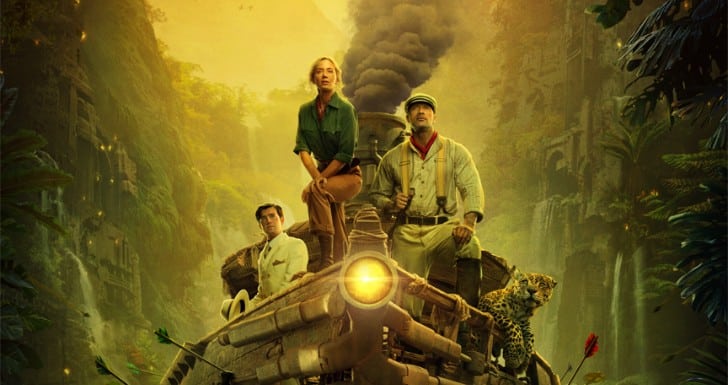
One of Adventureland's first attractions,
Jungle Cruise, was already at
Disneyland in 1955. Still popular to this day, the attraction takes you on a boat ride down the river. It is currently running at the parks in Anaheim, California, the Magic Kingdom at Walt Disney World in Florida, and Tokyo Disneyland and Hong Kong Disneyland.
The Settings

The sets for
"Jungle Cruise" were no easy task, and one of the most labor-intensive was the magnificent riverside scenery of Old Port, built-in and around a hilltop lake. It was on the Hawaiian Island of Kauai and involved a crew of more than a hundred crew members, from builders, painters, and sculptors, to landscaping and marine safety.
A Polyglot Movie
 Disney's new adventure film
Disney's new adventure film is full of languages. In addition to English, we get to hear ancient 16th century Spanish and Omagua, a language from the Tupi-Guarani language family of southwestern Brazil. We also heard Italian and Portuguese.
Special Filter Lenses
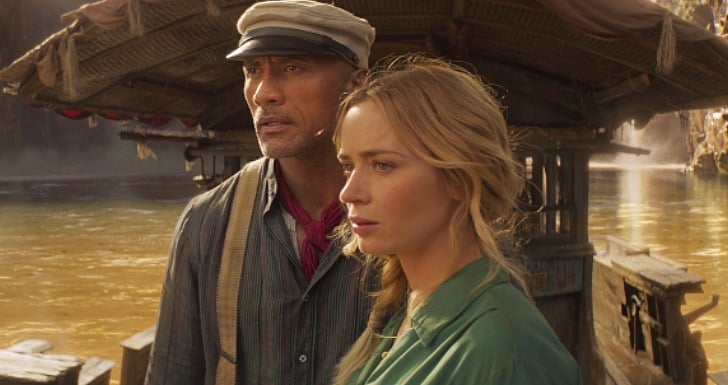 Specially created by Panavision for the movie
Specially created by Panavision for the movie, new lenses were used for the first time in the world. Panavision's special lenses have a yellowish sepia tone, which gives the magnificent, sunny feel of the Amazon in the early 1900s.
The Makeup Work

If, on the one hand, the most recent Disney film, "Cruella," bet heavily on costumes, here, in
"Jungle Cruise," there was a bet on makeup. Oscar-winning makeup designer Joel Harlow had to focus at one point on about 400 secondary characters - the needs ranging from sunburns to insect bites and 65 tribe members who needed fake piercings, body paint, and tattoos.
Proxima The Jaguar

A ferocious beast,
Proxima is the pet jaguar of Captain Frank Wolff (Dwayne Johnson). Despite his realistic features, sounds, and movements, he is a character made entirely through computer-generated imagery.
La Quila
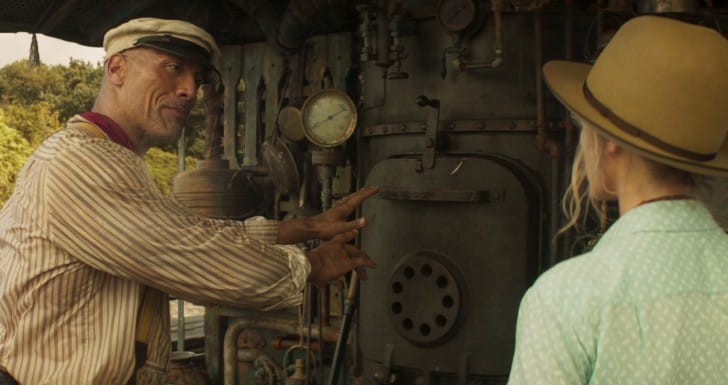 La Quila
La Quila is
Captain Frank Wolff's boat and is actually a fully functional and seaworthy vessel. Described as "a fragile steamboat, but with attitude" by Dwayne Johnson, the boat was outfitted with various gadgets by Jean-Vincent Puzos, production designer, and James (J.D.) Schwalm, special effects supervisor, and Oscar winner.
The La Quila Double

The boat was one of the film's protagonists, but the truth is that it also had its double! The second version of
La Quila has 136 kg and was used for stunts. The boat was attached to an underwater turntable for specific tasks such as whirling, rocking back and forth, and leaning sideways.
Watertight Testing

An outdoor oval water tank of approximately 1893 gallons was built in the back of
Blackhall Studios in Atlanta, with an underwater hydraulic system that put
La Quila to the test, bombarding it with about 273 gallons of water per minute. With La Quila attached, the turntable rocked and spun and tilted Dwayne Johnson, Emily Blunt, and Jack Whitehall in all directions!
An Eco-Friendly Boat
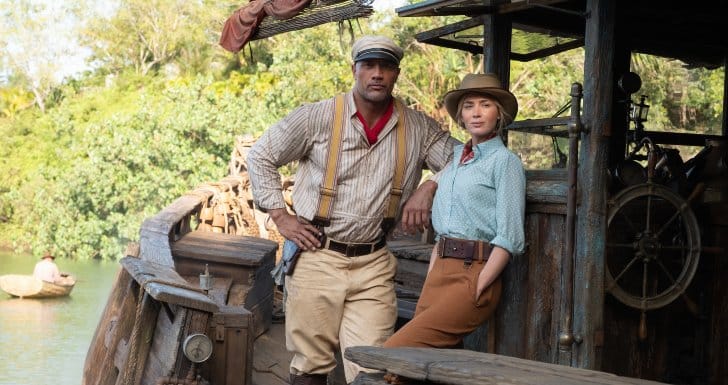
Despite its 15 tons and the original plan for a 250 horsepower gasoline engine, the truth is that the team did not use any fuel to power
La Quila. Instead, to be more ecological, the filmmakers opted for electric motors; since the largest ones have only 80 horsepower, two engines were used, reaching a speed of seven knots.
Costumes
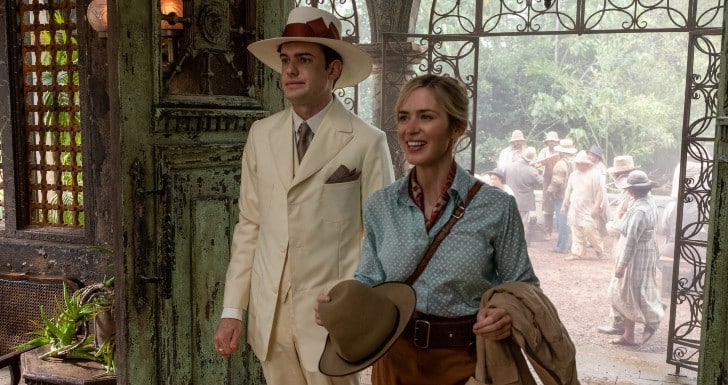
The costumes for
"Jungle Cruise" cover a wide variety of periods in history - from the 1950s Spanish conquistadors to the citizens of the early 1900s and indigenous peoples of the jungle.
Renaissance Inspiration

Oscar-nominated costume designer
Paco Delgado examined several
Spanish Renaissance armors that belonged to royalty or people at court for the conquistador characters. It was not armored to go to war, but armor for parades or shows. Only the beauty of the armors led the filmmakers to want to combine these designs for the film. So Paco Delgado found a workshop in Budapest that could traditionally replicate the armors, carving all the details by hand and using gold leaf.
 One of Adventureland's first attractions, Jungle Cruise, was already at Disneyland in 1955. Still popular to this day, the attraction takes you on a boat ride down the river. It is currently running at the parks in Anaheim, California, the Magic Kingdom at Walt Disney World in Florida, and Tokyo Disneyland and Hong Kong Disneyland.
One of Adventureland's first attractions, Jungle Cruise, was already at Disneyland in 1955. Still popular to this day, the attraction takes you on a boat ride down the river. It is currently running at the parks in Anaheim, California, the Magic Kingdom at Walt Disney World in Florida, and Tokyo Disneyland and Hong Kong Disneyland.  The sets for "Jungle Cruise" were no easy task, and one of the most labor-intensive was the magnificent riverside scenery of Old Port, built-in and around a hilltop lake. It was on the Hawaiian Island of Kauai and involved a crew of more than a hundred crew members, from builders, painters, and sculptors, to landscaping and marine safety.
The sets for "Jungle Cruise" were no easy task, and one of the most labor-intensive was the magnificent riverside scenery of Old Port, built-in and around a hilltop lake. It was on the Hawaiian Island of Kauai and involved a crew of more than a hundred crew members, from builders, painters, and sculptors, to landscaping and marine safety.  Disney's new adventure film is full of languages. In addition to English, we get to hear ancient 16th century Spanish and Omagua, a language from the Tupi-Guarani language family of southwestern Brazil. We also heard Italian and Portuguese.
Disney's new adventure film is full of languages. In addition to English, we get to hear ancient 16th century Spanish and Omagua, a language from the Tupi-Guarani language family of southwestern Brazil. We also heard Italian and Portuguese.  Specially created by Panavision for the movie, new lenses were used for the first time in the world. Panavision's special lenses have a yellowish sepia tone, which gives the magnificent, sunny feel of the Amazon in the early 1900s.
Specially created by Panavision for the movie, new lenses were used for the first time in the world. Panavision's special lenses have a yellowish sepia tone, which gives the magnificent, sunny feel of the Amazon in the early 1900s.  If, on the one hand, the most recent Disney film, "Cruella," bet heavily on costumes, here, in "Jungle Cruise," there was a bet on makeup. Oscar-winning makeup designer Joel Harlow had to focus at one point on about 400 secondary characters - the needs ranging from sunburns to insect bites and 65 tribe members who needed fake piercings, body paint, and tattoos.
If, on the one hand, the most recent Disney film, "Cruella," bet heavily on costumes, here, in "Jungle Cruise," there was a bet on makeup. Oscar-winning makeup designer Joel Harlow had to focus at one point on about 400 secondary characters - the needs ranging from sunburns to insect bites and 65 tribe members who needed fake piercings, body paint, and tattoos.  A ferocious beast, Proxima is the pet jaguar of Captain Frank Wolff (Dwayne Johnson). Despite his realistic features, sounds, and movements, he is a character made entirely through computer-generated imagery.
A ferocious beast, Proxima is the pet jaguar of Captain Frank Wolff (Dwayne Johnson). Despite his realistic features, sounds, and movements, he is a character made entirely through computer-generated imagery.  La Quila is Captain Frank Wolff's boat and is actually a fully functional and seaworthy vessel. Described as "a fragile steamboat, but with attitude" by Dwayne Johnson, the boat was outfitted with various gadgets by Jean-Vincent Puzos, production designer, and James (J.D.) Schwalm, special effects supervisor, and Oscar winner.
La Quila is Captain Frank Wolff's boat and is actually a fully functional and seaworthy vessel. Described as "a fragile steamboat, but with attitude" by Dwayne Johnson, the boat was outfitted with various gadgets by Jean-Vincent Puzos, production designer, and James (J.D.) Schwalm, special effects supervisor, and Oscar winner.  The boat was one of the film's protagonists, but the truth is that it also had its double! The second version of La Quila has 136 kg and was used for stunts. The boat was attached to an underwater turntable for specific tasks such as whirling, rocking back and forth, and leaning sideways.
The boat was one of the film's protagonists, but the truth is that it also had its double! The second version of La Quila has 136 kg and was used for stunts. The boat was attached to an underwater turntable for specific tasks such as whirling, rocking back and forth, and leaning sideways.  An outdoor oval water tank of approximately 1893 gallons was built in the back of Blackhall Studios in Atlanta, with an underwater hydraulic system that put La Quila to the test, bombarding it with about 273 gallons of water per minute. With La Quila attached, the turntable rocked and spun and tilted Dwayne Johnson, Emily Blunt, and Jack Whitehall in all directions!
An outdoor oval water tank of approximately 1893 gallons was built in the back of Blackhall Studios in Atlanta, with an underwater hydraulic system that put La Quila to the test, bombarding it with about 273 gallons of water per minute. With La Quila attached, the turntable rocked and spun and tilted Dwayne Johnson, Emily Blunt, and Jack Whitehall in all directions!  Despite its 15 tons and the original plan for a 250 horsepower gasoline engine, the truth is that the team did not use any fuel to power La Quila. Instead, to be more ecological, the filmmakers opted for electric motors; since the largest ones have only 80 horsepower, two engines were used, reaching a speed of seven knots.
Despite its 15 tons and the original plan for a 250 horsepower gasoline engine, the truth is that the team did not use any fuel to power La Quila. Instead, to be more ecological, the filmmakers opted for electric motors; since the largest ones have only 80 horsepower, two engines were used, reaching a speed of seven knots.  The costumes for "Jungle Cruise" cover a wide variety of periods in history - from the 1950s Spanish conquistadors to the citizens of the early 1900s and indigenous peoples of the jungle.
The costumes for "Jungle Cruise" cover a wide variety of periods in history - from the 1950s Spanish conquistadors to the citizens of the early 1900s and indigenous peoples of the jungle.  Oscar-nominated costume designer Paco Delgado examined several Spanish Renaissance armors that belonged to royalty or people at court for the conquistador characters. It was not armored to go to war, but armor for parades or shows. Only the beauty of the armors led the filmmakers to want to combine these designs for the film. So Paco Delgado found a workshop in Budapest that could traditionally replicate the armors, carving all the details by hand and using gold leaf.
Oscar-nominated costume designer Paco Delgado examined several Spanish Renaissance armors that belonged to royalty or people at court for the conquistador characters. It was not armored to go to war, but armor for parades or shows. Only the beauty of the armors led the filmmakers to want to combine these designs for the film. So Paco Delgado found a workshop in Budapest that could traditionally replicate the armors, carving all the details by hand and using gold leaf. 
